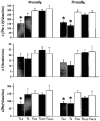Slow recovery of impaired phrenic responses to hypoxia following perinatal hyperoxia in rats
- PMID: 9706034
- PMCID: PMC2231139
- DOI: 10.1111/j.1469-7793.1998.599bh.x
Slow recovery of impaired phrenic responses to hypoxia following perinatal hyperoxia in rats
Abstract
1. Previous studies demonstrated that both ventilatory and phrenic nerve responses to acute hypoxia are greatly attenuated in adult rats (3-5 months old) previously exposed to 1 month of perinatal hyperoxia (60 % O2; perinatal treated rats). The present study tested the hypothesis that this functional impairment recovers spontaneously with advancing age in perinatal treated rats. 2. Hypoxia-induced chemoreflexes were examined by measuring integrated phrenic responses to strictly controlled isocapnic hypoxia in urethane-anaesthetized, vagotomized, paralysed and ventilated rats at different ages. 3. At 50 mmHg Pa,O2 (arterial O2 partial pressure), the hypoxia-induced increase in minute phrenic activity was significantly attenuated in both 3- to 5-month-old (166 +/- 15% of baseline) and 6-month-old (130 +/- 17%) perinatal treated rats, relative to 3- to 6-month-old, untreated control rats (279 +/- 28%; both P < 0.05). However, at 40 mmHg Pa,O2, the hypoxic minute phrenic activity response was attenuated only in 3- to 5-month-old (154 +/- 33%), but not 6-month-old (232 +/- 33%) perinatal treated rats versus control rats (293 +/- 30%). 4. The minute phrenic activity response to hypoxia was not significantly different between geriatric perinatal treated rats (14-15 months) and untreated geriatric control rats at either 50 mmHg (treated: 250 +/- 20% versus control: 274 +/- 23%) or 40 mmHg Pa,O2 (treated: 292 +/- 19% versus control: 315 +/- 36%). 5. These data suggest that partial spontaneous recovery may occur in 6-month-old perinatal treated rats and that full recovery occurs by 15 months of age.
Figures

Similar articles
-
Life-long impairment of hypoxic phrenic responses in rats following 1 month of developmental hyperoxia.J Physiol. 2002 Feb 1;538(Pt 3):947-55. doi: 10.1113/jphysiol.2001.012908. J Physiol. 2002. PMID: 11826178 Free PMC article.
-
Induced recovery of hypoxic phrenic responses in adult rats exposed to hyperoxia for the first month of life.J Physiol. 2001 Nov 1;536(Pt 3):917-26. doi: 10.1111/j.1469-7793.2001.00917.x. J Physiol. 2001. PMID: 11691883 Free PMC article.
-
Phrenic responses to isocapnic hypoxia in adult rats following perinatal hyperoxia.Respir Physiol. 1997 Aug;109(2):107-16. doi: 10.1016/s0034-5687(97)00045-5. Respir Physiol. 1997. PMID: 9299642
-
Developmental plasticity of the hypoxic ventilatory response.Respir Physiol. 1997 Nov;110(2-3):261-8. doi: 10.1016/s0034-5687(97)00091-1. Respir Physiol. 1997. PMID: 9407619 Review.
-
Developmental plasticity of the hypoxic ventilatory response after perinatal hyperoxia and hypoxia.Respir Physiol Neurobiol. 2005 Nov 15;149(1-3):287-99. doi: 10.1016/j.resp.2005.04.003. Respir Physiol Neurobiol. 2005. PMID: 16203217 Review.
Cited by
-
Hypoxic pulmonary vasoconstriction, carotid body function and erythropoietin production in adult rats perinatally exposed to hyperoxia.J Physiol. 2015 Jun 1;593(11):2459-77. doi: 10.1113/JP270274. Epub 2015 May 15. J Physiol. 2015. PMID: 25833164 Free PMC article.
-
Life-long impairment of hypoxic phrenic responses in rats following 1 month of developmental hyperoxia.J Physiol. 2002 Feb 1;538(Pt 3):947-55. doi: 10.1113/jphysiol.2001.012908. J Physiol. 2002. PMID: 11826178 Free PMC article.
-
Induced recovery of hypoxic phrenic responses in adult rats exposed to hyperoxia for the first month of life.J Physiol. 2001 Nov 1;536(Pt 3):917-26. doi: 10.1111/j.1469-7793.2001.00917.x. J Physiol. 2001. PMID: 11691883 Free PMC article.
-
Prenatal hypoxia impairs the postnatal development of neural and functional chemoafferent pathway in rat.J Physiol. 2000 Apr 15;524 Pt 2(Pt 2):525-37. doi: 10.1111/j.1469-7793.2000.00525.x. J Physiol. 2000. PMID: 10766931 Free PMC article.
-
Responses of single-unit carotid body chemoreceptors in adult rats.J Physiol. 2001 Feb 15;531(Pt 1):165-70. doi: 10.1111/j.1469-7793.2001.0165j.x. J Physiol. 2001. PMID: 11179400 Free PMC article.
References
-
- Antonini A, Stryker MP. Plasticity of geniculocortical afferents following brief or prolonged monocular occlusion in the cat. Journal of Comparative Neurology. 1996;369:64–82. 10.1002/(SICI)1096-9861(19960520)369:1<64::AID-CNE5>3.3.CO;2-N. - DOI - PubMed
-
- Fukuda Y. Changes in ventilatory response to hypoxia in the rat during growth and aging. Pflügers Archiv. 1992;421:200–203. - PubMed
Publication types
MeSH terms
Grants and funding
LinkOut - more resources
Full Text Sources

